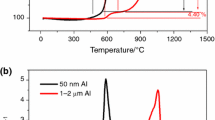Abstract
The mechanism of the oxidation of disperse aluminum (powder of ASD-4 grade) by liquid water was studied including the use of different process activation methods (thermal, ultrasonic, and chemical in the presence of small CaO amounts). For this purpose, the complex study of the aluminum oxidation process was performed at its different stages by analyzing the kinetic dependences of the hydrogen formation rate and the reaction medium pH change and using the instrumental methods of scanning electron microscopy and X-ray diffraction analysis. It has been demonstrated that the shape of kinetic hydrogen release curves, the oxidation process completeness, and the structure of formed hydroxides are interrelated. An essential role is played by the mass transfer of formed solid oxidation products from the surface of particles to the crystallization nuclei of aluminum hydroxide and the localization of crystallization areas. This work is topical because of the broad interest in the use of metallic aluminum as an energy-accumulating substance.
Similar content being viewed by others
References
M. N. Larichev (L. M. Nikolaevich), in Metal Nano-powders: Production, Characterization, and Energetic Applications, Ed. by A. Gromov and U. Teipel (Wiley-VCH, Weinheim, 2014), p. 163. https://doi.org/10.1002/9783527680696.ch8
H. Z. Wang, D. Y. C. Leung, M. K. H. Leung, et al., Renewable Sustainable Energy Rev. 13, 845 (2009). https://doi.org/10.1016/j.rser.2008.02.009
E. I. Shkolnikov, A. Z. Zhuk, and M. S. Vlaskin, Renewable Sustainable Energy Rev. 15, 4611 (2009). https://doi.org/10.1016/j.rser.2011.07.091
M. N. Larichev, O. O. Laricheva, I. O. Leipunskii, et al., Izv. Akad. Nauk, Energ., No. 5, 125 (2007).
J. M. Bergthorson, Y. Yavor, J. Palecka, et al., Appl. Energy 186, 13 (2017). https://doi.org/10.1016/j.apenergy.2016.10.033
A. Z. Zhuk, M. S. Vlaskin, A. V. Grigorenko, et al., J. Ceram. Proc. Res. 17, 910 (2016).
S. A. Kislenko, M. S. Vlaskin, and A. Z. Zhuk, Solid State Ionics 293, 1 (2016).
M. N. Larichev, N. S. Shaitura, and O. O. Laricheva, Russ. J. Phys. Chem. B 2, 757 (2008). https://doi.org/10.1134/S1990793108050175
M. N. Larichev, N. S. Shaitura, V. N. Kolokol'nikov, et al., Izv. Akad. Nauk, Energet, No. 2, 85 (2010).
N. S. Shaytura, M. N. Laritchev, O. O. Laritcheva, et al., Curr. Appl. Phys. 10 (Suppl. 2), S66 (2010). https://doi.org/10.1016/j.cap.2009.11.044
M. N. Larichev, N. S. Shaitura, V. N. Kolokol'nikov, et al., Perspekt. Mater., No. 9, 289 (2010).
M. N. Larichev, O. O. Laricheva, N. S. Shaitura, et al., Izv. Akad. Nauk, Energ., No. 3, 66 (2012).
A. A. Gromov, A. P. Il'in, U. Foerter-Barth, et al., Combust., Explos., Shock Waves 42, 177 (2006).
M. N. Larichev, O. O. Laricheva, I. O. Leipunskii, et al., Khim. Fiz. 25 (10), 72 (2006).
Z. Y. Deng, J. M. F. Ferreira, Y. Tanaka, and J. Ye, J. Am. Ceram. Soc. 90, 1521 (2007). https://doi.org/10.1111/j.1551-2916.2007.01546.x
A. Fernandez, J. C. Sanchez-Lopez, A. Caballero, et al., J. Microsc. 191, 212 (1998). https://doi.org/10.1046/j.1365-2818.1998.00355.x
S. S. Razavi-Tousi and J. A. Szpunar, Electrochim. Acta 127, 95 (2014). https://doi.org/10.1016/j.electacta.2014.02.024
A. S. Lozhkomoev, E. A. Glazkova, O. V. Bakina, et al., Nanotecnology 27, 205603 (2016). https://doi.org/10.1088/0957-4484/2720/205603
S. Kanehira, S. Kanamori, K. Nagashima, et al., J. Asian Ceram. Soc. 1, 296 (2013). https://doi.org/10.1016/jjascer.2013.08.001
B. C. Bunker, G. C. Nelson, K. R. Zavadil, et al., J. Phys. Chem. B 18, 4705 (2002). https://doi.org/10.1021/jp013246e
E. I. Shkolnikov, N. S. Shaitura, and M. S. Vlaskin, J. Supercrit. Fluids 73, 10 (2013). https://doi.org/10.1016/j.supflu.2012.10.011
P.A. Rebinder and E. D. Shchukin, Sov. Phys. Usp. 15, 533 (1972). https://doi.org/10.3367/UFNr.0108.197209a.0003
J. Zang, M. Klasky, and B. C. Letellier, J. Nucl. Mater. 384, 175 (2009). https://doi.org/10.1016/j.jnucmat.2008.11.009
W. H. Song, J. J. Du, Y. L. Xu, et al., J. Nucl. Mater. 246, 139 (1997). https://doi.org/10.1016/S0022-3115(97)00146-3
I. B. Ulanovskiy, Hydrogen Diffusion and Porosity Formation in Aluminium (MISIS, Moscow, 2015) [in Russian].
I. L. Khodakovskii, L. V. Katorcha, and N. S. Kuyunko, Geokhimiya, No. 11, 1606 (1980).
X. Feng, Z. Baojie, and L. Chery, J. Environ. Sci., No. 20, 907 (2008). https://doi.org/10.1016/S1001-0742(08)62185-3
P. F. Rumyantsev, V. S. Khotimchenko, and V. Sh. Niku-shchenko, Calcium Aluminates Hydration (Nauka, Leningrad, 1974) [in Russian].
R. A. Lidin, et al., Chemical Properties of Inorganic Substances, 3rd ed. (Khimiya, Moscow, 2000) [in Russian].
M. D. Luque de Castro and F. Priego-Capete, Ultrason. Sonochem. 14, 717 (2007).
V. S. Nalajala and V. S. Moholkar, Ultrason. Sonochem. 18, 345 (2011).
M. A. Margulis, Ultrasonics 23, 157 (1985). https://doi.org/10.1016/0041-624X(85)90024-1
B. Kaspzyk-Hordern, Adv. Colloid Interface Sci. 110, 19 (2004). https://doi.org/10.1016/j.cis.2004.02002
Author information
Authors and Affiliations
Corresponding author
Additional information
Russian Text © The Author(s), 2019, published in Khimicheskaya Fizika, 2019, Vol. 38, No. 3, pp. 9–23.
Rights and permissions
About this article
Cite this article
Shaitura, N.S., Laricheva, O.O. & Larichev, M.N. Studying the Mechanism of the Low-Temperature Oxidation of Microsized Aluminum Powder by Water. Russ. J. Phys. Chem. B 13, 231–244 (2019). https://doi.org/10.1134/S1990793119020088
Received:
Revised:
Accepted:
Published:
Issue Date:
DOI: https://doi.org/10.1134/S1990793119020088



